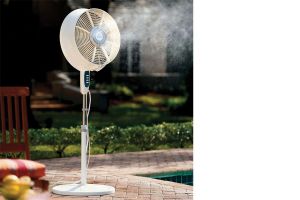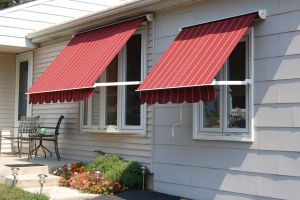The current hot spell can be a killer. We know that. However, that does not warrant us to run out to get air-conditioner units for the whole house. Cooling our homes in this hot weather can account for 45 percent of our home energy use, yet it could be reduced to 10 percent or less with a few thoughtful changes. We’ve tried to find the best ways to stay cool without using the air conditioner, and offering you the easiest, cheapest tips you can do right now to cool off.
Incorporating natural ventilation into your home will help you slash your energy use and carbon emissions drastically. Remember – even if you have and use an air conditioner, these tips can help you reduce your need for it, saving both energy and money.
Table of Contents
1. Install ceiling insulation
It may cost you a bit but if you don’t mind the renovation or in midst of decorating your house, don’t forget to install ceiling insulation as it can reduce hot air from coming into your home through the roof. There are also paint for roof tiles and exterior wall available in the market that can reduce the absoption of heat to a great extend.
2. Light paint your home
If it’s possible, paint your interior walls in a cool, neutral colour as bright colours like yellow absorb heat.
Close your windows
Windows make a big difference in the temperature of a room. It may seem counterintuitive, but on hot days, opening the windows will often make your home warmer, not cooler. Open your windows only at night if the air outside is cooler than inside, and close them – along with blinds and shades – before the sun hits your house in the morning.
3. Head downstairs
Since hot air rises, the upper stories of a home will be warmer than the ground floor. The lowest floor can be a cool refuge from the midday heat.
4. Use fans strategically
Ceiling fans use a fraction of the energy of an air conditioner and can be more effective at cooling the whole space when well placed. Using ceiling fans in combination with natural ventilation can usually eliminate the need for air conditioning in a well-insulated, tightly sealed home. Be sure that you have the fan running in the right direction.
You should feel the breeze blowing down. And remember, ceiling fans cool people, not rooms, so turn it off when you leave the room.
If you’re buying new ceiling fans, make sure you buy Energy Star ceiling fans that use 50% less energy than comparable models – a choice that will pay off in the long run, as you can appreciate the longer you keep your fan running.
5. Try using a water misting fan
These portable devices are battery operated so you can take them with you wherever you go. As you mist and fan yourself, the water is evaporated on your skin, giving you an instant cooling sensation.
6. Don’t heat up the kitchen
This is difficult in many Malaysian homes. But try using the grill rather than the stove. Remember, kitchen appliances aren’t the only devices that give off heat; limiting your use of electronics and lighting will help keep your home cooler, too. When possible, delay heat-generating activities such as dishwashing until evening on hot days.
7. Use energy saving lights
While modern lightning, like compact fluorescents and LEDs, are more efficient, incandescent light bulbs can produce as much heat as they do light. Energy Star-rated light bulbs produce 75% less heat, so consider that when replacing bulbs.
8. Shut off lights when not in use
It’s always a good idea to shut off lights to save energy, and on hot days, it can also affect the temperature of the room. The same goes for many electronics, so consider unplugging any device that isn’t needed, since even in standby mode, many electronics remain hot.
9. Plant trees strategically
Let nature help reduce your energy bills by planting trees on the east and west sides of your home. During hot weather, their broad leaves will shade your house. Also consider planting trees or shrubs to shade high-heat areas – air conditioning units that emit heat, for instance, and driveways and walkways that absorb it.
You may also place house plants – particularly larger potted trees – in front of sunny windows to absorb some of the sun’s heat. Of course, sitting under a shady tree on a hot day isn’t a bad way to pass the time, wherever the tree stands!
10. Install awnings
Just as window shades and shrubbery work to shield your home from the sun’s rays, awnings can save you money on energy bills by cutting down on the heat your house absorbs. Make sure they are not heat trapping awnings made of metal or glass.
11. Install shades and blinds
Install white window shades or mini-blinds. Mini-blinds can reduce solar heat gain by 40-50 percent. Hang tightly woven screens or bamboo shades outside the window to stop 60 to 80 percent of the sun’s heat from getting to the windows.
12. Eat cold meals
Just as drinking a nice cold cocktail cools your body, eating cold food helps keep your internal temperature lower on a hot day. Try a simple watermelon salad, for instance, or a cold soup. Be careful though, as Traditional Chinese
Medicine restrict eating too much cold food and frosty drinks. Ice cream, shave ice, smoothies, and shakes are extremely cold and sweet. Eaten in excess, they can cause problems not only in the digestive system but in the respiratory system and reproductive system as well, like diarrhoea, mucus and phlegm.
13. Don’t eat large, protein-rich meals
Doing so can increase metabolic heat and warm the body.
14. Maintain an adequate level of hydration
Meaning you’ll need to consume more water than you usually do when it’s hot. If you’re sweating profusely, you will also need to replace electrolytes by eating a small amount of food with your water or by drinking specially-formulated electrolyte replacement drinks. Thirst is the first sign of dehydration; you should drink sufficient amounts of fluids before you feel thirsty in order to prevent dehydration.
15. Dress appropriately
Wear light colours. Darker colours will absorb the sun’s heat and stay warmer longer than light or white clothing, which reflects light and heat. Wear natural summer clothing.
16. Take a cold shower or go swimming
It may sound obvious, but it’s worth saying: If you’re hot, cool off your core temperature by immersing yourself in cold water. Unless there’s 100% humidity, the evaporation of water off your skin will further cool you once you emerge from the water.
17. Place an ice cube on your pulse points
Take an ice cube, and place it in a wash cloth or handkerchief. Hold the ice cube to your pulse points in your wrists and/or neck for up to thirty seconds. By some estimates, this cools your body temperature an amazing three degrees – which makes a big difference when you’re hoping for some relief from the heat.
18. Cold washcloth on your neck
Wet a washcloth with cold water. (If you’re really warm, consider placing it in the freezer for a few minutes.) Wring it out, and hold it to the back of your neck. You’ll feel instantly cool.
Soak your feet in cold water
You can get a cooling effect by filling a small tub or large pot with cold water and soaking your feet for a little while. Ladies out there, if you want a little extra pampering, why not give yourself a pedicure when you’re finished soaking your feet?


















